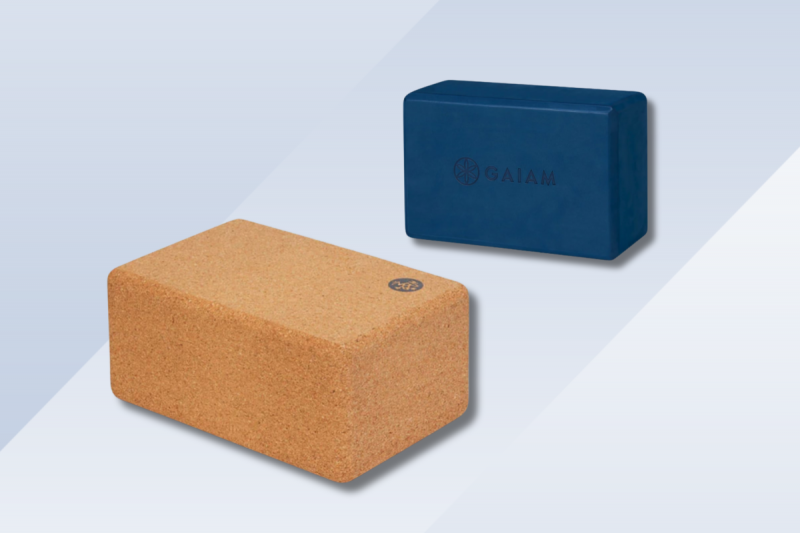Often stacked in a corner of a yoga studio or tucked away in a closet, yoga blocks are “a greatly underutilized prop,” according to registered yoga teacher Mandy Enright. While it may be tempting to think they’re only for beginners or those with limited flexibility, Enright emphasizes that “everyone can benefit from using blocks, regardless of experience level.” The key is finding the best yoga block for your practice.
Quick Overview
-
Best overall
Alo Uplifting Yoga Block
$28 at Alo
-
Best cork
Manduka Cork Yoga Block
$24 at Manduka
-
Best compact
JadeYoga Small Yoga Block
$18 at JadeYoga
-
Best curved
Lululemon Inner Flow Yoga Block
$28 at Lululemon
- More options
Best budget
Gaiam Yoga Block
$10 at Get Actv$10 at AmazonSee more options
On the most basic level, yoga blocks help bring the ground closer to your fingertips; or stated another way, they shorten the distance you need to move to touch the “ground.” After all, it’s comparatively easier to bend over and touch the top of a block than to bend over and touch the ground itself. However, as our experts shared, blocks have many other benefits, including improving alignment and deepening stretches. They can also provide support during restorative poses, like restorative fish pose, and even be used for extra resistance during abdominal workouts.
“For people who are growing their yoga practices and working toward more advanced postures, blocks are a key tool. Blocks can help with arm balances, inversions and press practices. They’re also excellent for enhancing balance. You can make balancing poses more challenging if you try the pose while standing on a block,” explains Enright.
Unlike yoga mats, shopping for a yoga block is more straightforward. Most blocks are made from foam, cork or wood and come in a standard size. That said, larger and smaller blocks are available, as are options with curved sides.
To better understand the uses of yoga blocks and the differences between types, our team spoke with three yoga instructors, researched more than 10 yoga brands and put eight blocks to the test. Here are our top picks for the best yoga block.
Best yoga block overall
Alo
Best overall
Alo Uplifting Yoga Block
Sizing: Standard | Materials: EVA foam | Dimensions: 4 x 6 x 9 inches | Weight: 0.6 pounds
The Alo Uplifting Yoga Block is our best overall yoga block thanks to its beveled edges, excellent grip (even when sweaty) and durable EVA foam. Plus, despite weighing less than a pound, the block remained stable and supportive, even when our balance was shaky during half moon pose.
If you’re only going to buy one type of yoga block, many of our experts agree that a foam block is your best bet. They’re generally lighter and more comfortable than wood or cork blocks, making them more versatile — which rang true during testing. The Alo Uplifting Block was lightweight for core exercises, comfortable during restorative poses and stable during balance work.
The biggest drawback is the price. At $28 per block, it’s certainly not a budget-friendly option, especially if you purchase two. However, if you plan on using it regularly, the quality makes it worth the higher cost. We also like that it comes in multiple colors including various neutrals, black, white and even a highlighter yellow, allowing you to flex a little style or match your mat, if you’re so inclined.
Pros
- Great grip, even when sweaty
- Lightweight yet stable
- Comfortable
- Beveled edges
- Available in multiple colors
Cons
- Expensive
- Only available in standard size
$28 at Alo
More yoga blocks we like for 2024
Manduka
Best cork
Manduka Cork Yoga Block
Sizing: Standard or “lean” | Materials: Sustainably sourced fine-grain cork | Dimensions: 4 x 6 x 9 inches | Weight: 2.2 pounds
The Manduka Cork Yoga Block stands out from the competition for its sturdy, eco-friendly construction. Specifically, the block is made from dense, fine-grain cork, giving it an impressively solid feel even during challenging poses. The material also makes it easy to grip, even when your hands get sweaty, and the beveled edges offer a comfortable grip.
While I ultimately preferred the smoother texture and lighter weight of the overall winner, I was pleasantly surprised by how comfortable the Manduka Cork Block is even during restorative poses.
Manduka products aren’t cheap — you’ll lay out just under $50 for a set of these blocks — but they will likely last longer. According to yoga instructor Marisa Barsotti, “My personal brand of choice tends to be Manduka for mats and blocks. They are more expensive, but I have had the same props for over a decade.”
You can also get this block in the “lean” size, which is a little shorter and narrower than the original, making it a slightly more travel-friendly option.
Pros
- Durable, sturdy construction
- Great grip
- Sustainably sourced cork
- Available in a “lean” size
- Also sold as a 2-pack ($46)
Cons
- Heavy
- Relatively expensive
$24 at MandukaJadeYoga
Best compact
JadeYoga Small Yoga Block
Sizing: Small (large size also available) | Materials: Sustainably harvested cork | Dimensions: 3 x 4.75 x 9 inches | Weight: 1.1 pounds
The JadeYoga Small Yoga Block is the same height as a standard block but thinner and narrower, making it particularly good for those with smaller hands. We also found the block easier to maneuver, which is handy when you’re trying to make adjustments quickly during your flow.
The block is crafted from sustainably harvested cork, which is naturally antimicrobial and water-resistant. Similar to the Manduka block, the JadeYoga Block has a dense cork construction that provides plenty of grip and stability. The only downside is that the edges aren’t beveled, so the block isn’t quite as comfortable under your back or hips.
The Jade cork block is also 1.1 pounds lighter than the Manduka block. We appreciated the lighter weight, especially during abdominal exercises. Plus, its smaller footprint is convenient if you plan to practice outdoors or take it with you on vacation.
JadeYoga also offers a large version of the block, which features the same high-quality, sustainably sourced construction but is the width and thickness of a standard yoga block.
Pros
- Comfortable for smaller hands
- Great grip
- Lighter than the Manduka cork blocks
- Sustainably sourced cork
- Large size available
- Naturally antimicrobial
Cons
- Pointed edges may be uncomfortable
$18 at JadeYogaLululemon
Best curved
Lululemon Inner Flow Yoga Block
Sizing: One size | Materials: Dense foam, ethylene vinyl acetate | Dimensions: 3.5 x 5.9 x 9.8 inches | Weight: 0.8 pounds
Featuring a smooth, curved edge on one side, the Lululemon Inner Flow Yoga Block kept our hands more comfortable while holding half moon and standing splits than the brick-shaped blocks we tried. I found it to be a good joint-saving alternative if your wrists are often sore after using traditional yoga blocks.
The curved block is made from dense foam and offers good stability and grip. Even during a fast-paced vinyasa flow, I didn’t have issues with my hands sliding around. That said, the block is very firm. While the firmness is helpful for stability, I found it too hard for restorative poses where I placed the block under my back, neck or legs.
The cost is another important consideration, especially since it only comes with one block. Still, if you plan on using it regularly, and the pain in your hand or wrist keeps you from enjoying your practice, then the Inner Flow Yoga Block is worth the splurge.
Pros
- Lightweight yet stable
- Comfortable on hands and wrists
- Good grip
Cons
- Expensive
- Very firm
$28 at LululemonGaiam
Best budget
Gaiam Yoga Block
Sizing: Standard | Materials: EVA foam | Dimensions: 4 x 6 x 9 inches | Weight: 0.3 pounds
For a no-frills yoga block that won’t break the bank, it’s hard to compete with the Gaiam Yoga Block. The foam block is firm without being uncomfortable and weighs just 0.3 pounds, making it easy to maneuver or take on the go. It also offers beveled edges and a non-slip surface for a comfortable and supportive grip. Additional highlights include multiple color choices, an easy-clean surface and a 2-pack option for just $17.
While the block doesn’t offer the same sturdiness as the JadeYoga or Manduka cork blocks, we found the option from Gaiam to be stable and supportive enough for most basic yoga practices. However, this might not be the block for you if you plan on doing more advanced inversions and arm balances. Also, keep in mind that the block has a distinct chemical smell that takes a couple of weeks to dissipate.
Pros
- Budget-friendly
- Lightweight
- Beveled edges
- Comfortable, non-slip grip
- Available in multiple colors
- Also sold as a 2-pack ($17)
Cons
- Strong chemical smell
- Less sturdy than others
$10 at Get ActvExplore More Buying Options$10 at Amazon
Types of yoga blocks
Yoga blocks vary in size and even shape. However, the most significant differentiating factor is material. In general, yoga blocks are made from cork, foam or wood, each having pros and cons.
-
Cork: Cork blocks are eco-friendly and lightweight. Enright says that she recommends cork blocks for more challenging poses, like arm balances, because they don’t slide around as much. However, Barsotti warns that cork blocks “absorb sweat and smells and are difficult to clean.”
-
Foam: According to Enright, “foam blocks are my recommended all-around block to invest in.” Not only are they often the least expensive, but foam blocks are also lightweight, versatile, comfortable for restorative poses and easy to clean. The main downside? They’re not as eco-friendly as cork or wood blocks.
-
Wood: Wood blocks are generally heavier and longer-lasting than cork or foam blocks. However, Barsotti notes that they’re not as comfortable in restorative poses and can get slippery during sweaty yoga sessions.
Factors to consider when purchasing yoga blocks
From advancing posework to simply making yoga more accessible, yoga blocks are an important investment for any yoga practice. If you’re just starting your journey, it can be confusing to understand what your options are and which blocks to choose.
Some factors to keep in mind include:
-
Material: Yoga blocks come in various materials, including wood, foam and cork. The right choice depends on your practice style and how you plan to use the block. Consider what matters most to you, whether it’s durability, ease of cleaning, cost or environmental impact to find the material that best suits your needs.
-
Size: Standard yoga blocks are 9 inches tall, 6 inches wide and 4 inches deep. However, smaller and larger blocks are available, which may be more comfortable depending on your hand size and range of flexibility.
-
Shape: Most yoga blocks are shaped like rectangular bricks. However, some blocks have one rounded side or are fully egg-shaped, which may be more comfortable for backbends and reclining poses.
-
Price: Yoga blocks have varying prices and are usually sold individually. If you want to purchase two, consider lower-cost options to help you stay within your budget.
How we chose the best yoga blocks
To determine the best yoga blocks, we talked to three yoga experts, reviewed options from over 10 yoga brands and put eight blocks to the test.
During testing, we considered how comfortable the blocks were and how sturdy they felt during a 45-minute yoga class. We also noted how easy each block was to clean.
I’ve practiced yoga for more than 15 years and have grown to appreciate the benefits of yoga blocks, both in restorative and balance poses. I also have pretty tight hamstrings and have found yoga blocks essential for bringing the floor closer to my fingertips. In addition to the criteria above, I was particularly interested in blocks that are heavy enough for stability yet comfortable enough to support my lower back and neck in supine positions.
FAQs
How do I use yoga blocks?
There are countless ways to use yoga blocks during your practice. For example, blocks can be used during standing poses to help maintain balance or bring the ground closer to your fingers if you aren’t quite flexible enough to touch the floor. Blocks can support your neck or lower back when seated or lying down. Yoga blocks can also be used during strength exercises and core work.
What are the benefits of using yoga blocks?
According to yoga teacher and certified yoga therapist Ilene Cohen, “Yoga blocks are versatile props that offer numerous benefits to practitioners of all levels. They provide support, enhance alignment and deepen stretches, making them an invaluable addition to any yoga practice.”
What’s the difference between a rectangular and a curved yoga block?
Standard yoga blocks are shaped like rectangular bricks and can be used in various ways during your practice. Curved yoga blocks have either one rounded side or are fully egg-shaped and are designed to be more comfortable on your hands and neck.
How many blocks do I need?
Enright recommends purchasing two yoga blocks, allowing you to have one on either side of your mat. However, if cost is of concern, one block is still a great starting point.


